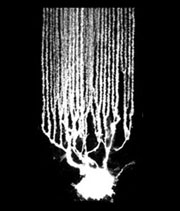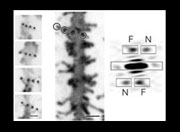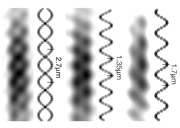Dendritic spines
Nerve cells communicate to each other at spines projecting from their dendritic shafts. There are more than 1014 such connections in the brain. What are the rules determining the positions of spines so that communication is optimised?
The elephant-nose fish, Gnathonemus petersii, provided an opportunity to examine this question. Purkinje cells in this electrically guided fish have exceptionally straight dendrites, making the rules governing spine organisation amenable to image analysis by the methods developed for electron microscopy.
The spines were highlighted in slices through unfixed tissue by labelling with lipid-soluble fluorescent dyes, delivered with a hand-held gene gun. Analysis of confocal images showed that spines have a preference to form regular linear arrays and trace short-pitch helical paths. The purpose of the helical organisation may be to maximise the opportunity of different spines to interact with different axons.
Key publication:
O’Brien, J. and Unwin, N. Organisation of spines on the dendrites of Purkinje cells. Proc. Natl. Acad. Sci. USA 103, 1575-1580 (2006). (pdf)




